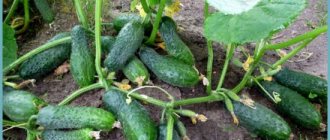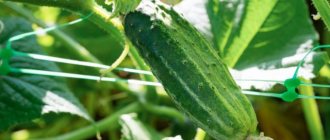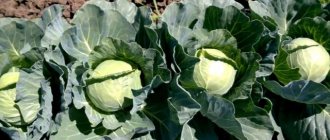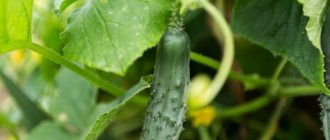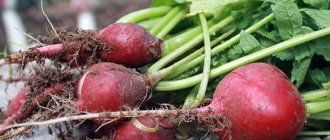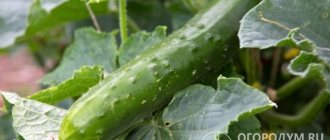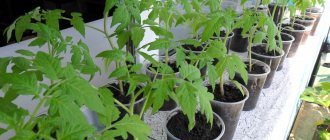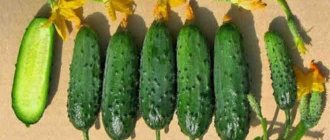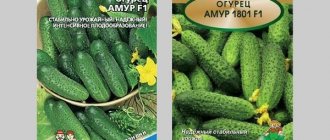In the 1960s and 70s, Soviet breeders created the first varieties of cucumbers that were resistant to cold and disease. One of them was Graceful. Gardeners who were engaged in farming back in those days are today proud that they have become pioneers in an important matter - testing new products that have not lost their relevance for four decades.
- 2 Characteristics and purpose of the fruits of this variety
- 3 Characteristics of the Graceful variety
- 4 Nuances of growing
4.1 Formation of graceful cucumbers
- 4.2 Video: how cucumber varieties (not hybrids) are grown in open ground
Breeding history
The variety was bred in the 60s of the last century under the leadership of O.V. Yurin by breeders of the All-Union Scientific Research Institute for Selection and Seed Production of Vegetable Crops (today – Federal State Budgetary Institution “Federal Scientific Center for Vegetable Growing”, VNIISSOK village, Moscow region).
Graceful became a continuation of the line of cold-resistant cucumbers, which includes varieties developed back in the 30s of the last century and which formed the basis for the further development of domestic selection. These include Vyaznikovsky 37 and Muromsky 36.
In 1971, Graceful was included in the State Register of the Russian Federation for cultivation in many regions of the country - from the central regions to the Far East. In general, it is approved for cultivation in areas such as:
- Far Eastern;
- East Siberian;
- West Siberian;
- Ural;
- Middle Volga;
- Volgo-Vyatsky;
- Central;
- Northwestern.
The Graceful cucumber is also in demand in neighboring countries, and since 1974 it has been listed in the State Register of Belarus.
Description of the variety
The Graceful cucumber is suitable for growing in open ground and spring film shelters. It is an early ripening variety, so it takes about 40-45 days from the first shoots to full ripening. How the plant blooms and what fruits it bears, we will look into separately.
Plant
The main characteristics of the plant are:
- bee-pollinated (ovaries develop in female flowers only after they are fertilized with pollen from male flowers, and the process of cross-pollination depends on the number and activity of insects);
- mixed according to the type of flowering (predominantly male flowers appear in the leaf axils of the central stem, and female flowers with ovaries appear on the lateral shoots of the first order);
- indeterminate (has no restrictions on growth);
- medium-climbing (medium-climbing can produce about 4-6 side shoots);
- medium-sized (moderate branching).
Fruit
With proper care of the plant, greens grow with the following parameters:
- length – from 9 to 12 cm;
- weight – 130-150 g;
- shape – flattened ellipse with weak ribbing;
- peel - medium density, light green with white stripes, white fluff and small tubercles;
- the pulp is without voids, dense, juicy and crispy, there is no bitterness.
Zelentsy have an excellent presentation, do not outgrow and do not turn yellow over time.
Characteristics table
The variety has a number of distinctive characteristics:
| Parameter | Description |
| Purpose | Elegant is considered a salad variety, so the fruits are often used in salads and served fresh. Meanwhile, most gardeners note that green vegetables are also suitable for pickling and canning. |
| Cold resistance | The variety tolerates cold weather well, so it is suitable for growing in northern regions with short summers. In addition, it is characterized by early ripening, so early planting can be done in order to harvest a stable harvest in short summer conditions. |
| Pollination method | The female inflorescences are pollinated by bees, which is why cucumbers have many male flowers. They also serve as pollinators for neighboring plants. |
| Disease resistance | The variety is famous for the fact that it is rarely susceptible to disease, having stable immunity. It is not afraid of powdery mildew, olive spot (cladosporiosis), or bacteriosis. |
| Productivity | From 1 sq. m of bed, you can collect 5-7 kg of greens. |
The characteristics of the variety are described in the following video:
Characteristics of cucumbers Elegant
Cucumber variety Graceful bee-pollinated variety. Absolutely easy to grow and care for. It has powerful, branched tops with a lot of green mass. The main stem is quite long – sometimes reaching 1.8 m.
Productivity and fruiting
The fruiting period is quite short, but abundant. Planted in June, the first fruits appear in mid-July - early August. After the first harvest, fruiting begins to decline due to the slowdown in crop growth.
This variety especially loves sun and abundant watering. If it's cold outside, the crop slows down in growth. When there is a significant cooling, the crop becomes sick and dies. Therefore, it is very important to provide cucumbers with reliable protection from frost and sudden temperature changes. During cold weather, the plant is covered with a special film. This is how you can achieve a good harvest.
During the fruiting period, up to 4-6 kg of fruit can be harvested from 1 m2. It is recommended to harvest at intervals of 2-3 days.
Cucumber variety Graceful during the fruiting period in the photo:
Application area
This variety is universal. These cucumbers are consumed fresh and often canned. The Elegant cucumber turns out very tasty in winter salads and pickles. Many summer residents prefer this particular variety, since after processing the fruits remain just as crispy.
Resistance to diseases and pests
Perhaps one of the disadvantages of the culture is its susceptibility to fungal infections. The Elegant cucumber is not afraid of olive spot, but it can be affected by aphids and powdery mildew. The crop is especially susceptible in cool and rainy times in densely planted areas.
Attention! To protect cucumbers from infection, you should select high-quality seed material and the right place for planting.
Aphid
If it happens that the plant has already been infected by aphids, you can treat the bushes with garlic infusion. 70 g of chopped garlic per bucket of water. The mixture is infused for a day, then preventative spraying is carried out.
Powdery mildew
A fungal infection, which is characterized by white spots in the form of plaque, very often affects cucumbers. Such crops lose their ovaries and eventually die completely.
To rid a plant of a disease, it is important to identify it in the first stages, otherwise there is a high risk of the disease affecting the entire summer cottage. At the first signs of damage to the bushes by powdery mildew, it is necessary to treat with a fungicide (“Pseudobacterin-2” or “Fitosporin-M”). It is worth noting that these drugs are absolutely safe for humans, so treatments can be performed during the fruiting period of the crop.
Important! By providing Elegant cucumbers with proper care, you can reduce the risk of contracting many diseases.
Advantages and disadvantages of the variety
Based on the description and characteristics of the Elegant cucumber, a number of advantages can be noted:
- 100% seed germination;
- presentation of the fruit;
- high survival rate of seedlings;
- resistance to minor cold snaps;
- can be used as a pollinator for other varieties;
- possibility of self-harvesting seeds;
- pleasant taste.
The disadvantages of almost any cucumber variety depend on the quality of care.
Minor disadvantages include:
- short fruiting period;
- susceptibility to aphids and powdery mildew;
- If there is insufficient watering, the fruits become bitter.
Attention! If the crop is not provided with sufficient watering, the cucumbers will bear fruit worse.
Agricultural technology
To get an excellent harvest, it is necessary to take into account the basic agrotechnical rules from the moment of sowing the seeds to harvesting the cucumbers:
- Grow the variety through direct sowing in the ground or by seedlings. You can sow seeds for seedlings in the middle zone in late April - early May, and transplant them to a permanent place in late May - early June.
Due to the relatively low soil temperature in the first time after planting, the plant develops a powerful root system, but the growth of its above-ground part slows down. In the future, this has a good effect on its early maturity, productivity and endurance.
- You can cultivate cucumbers in an area that is well-warmed by the sun and protected from drafts. The soil itself should be light and loose. It is desirable that crops such as: tomatoes have previously grown on it;
- peas;
- cabbage
- potato.
It is not recommended to plant cucumbers after pumpkins and zucchini.
Reviews
Tamara, 54 years old, Divnogorsk
The Graceful cucumber variety is among the tried and true old-timer cucumbers that we plant every year. Our summer in the Krasnoyarsk Territory is short, but this variety ripens quickly and manages to give us a good harvest of delicious cucumbers. They are bee-pollinated, which means they are natural and healthy, always sweet and juicy, without bitterness. They crunch great and smell amazing. We eat them fresh straight from the garden and cut them into all our summer salads. Picked cucumbers are stored well in the refrigerator and do not turn yellow. I don’t use this variety for canning; I prefer the black-thorned variety.
Kristina, 37 years old, Republic of Bashkortostan
We decided to give up growing old varieties of cucumbers, such as Izyaschny. Recently, many much more productive and stable ones have appeared, and with this we were left without a harvest for two years in a row. It was either attacked by mosaics, or by aphids, and then all the bushes died from downy mildew. It looks like they were treated and sprayed, but they didn’t even eat the cucumbers.
Mikhail, 42 years old, Bobruisk
I have been familiar with “Elegant” cucumbers for a very long time and have tried various recommendations for growing them. He let the lashes spread horizontally and pulled a trellis for them so that they stretched upward. This method of formation gave me the best results: I pinched the central shoot after 3-4 leaves, lowered the two lower side shoots to the ground and buried them in the folds, without covering the growth point, so that they took root. It turned out that the bush grew into 3 stems - on the central one there were mostly barren flowers for pollination, and on the powerful side ones, cucumbers began to actively grow. I pinched the second-order stepchildren after 2-3 leaves. The harvest was impressive all summer! We ate these cucumbers, salted them, and pickled them. They are good in all forms!
Aglaya, 58 years old, Yaroslavl region.
This cucumber fully lives up to its name. The bushes are not huge, and the cucumbers themselves are beautiful and not thick. Even if you look at a cucumber on a vine and it outgrows, it still remains tasty, the color remains green, the peel and seeds do not harden for a long time. I can’t pay much attention to the garden, but Graceful is so unpretentious and hardy that it bears fruit no matter what the weather. It responds gratefully to fertilizing with manure diluted in water and herbal infusions. It can easily do without pinching and the construction of various supports. It grows in our open ground. We plant our own seeds year after year. Cucumbers taste very pleasant - sweetish, juicy, strong. The skin is thin and non-prickly, you can pick it off and immediately eat it with pleasure.
Vladimir, 47 years old, Moscow region.
In my opinion, varieties like this are already obsolete. The cucumber itself is not bad. But in most characteristics it is in many respects inferior to more modern varieties and hybrids. The taste is good and the seeds are cheap; it copes well with our temperature changes and unfavorable weather conditions. Perhaps these are its main advantages. More suitable for beginner gardeners who do not want to bother with formation and care.
Seed preparation
It is extremely important to properly process the seed material, which involves the following manipulations:
- Calibrate seeds. First, keep them for several minutes in a weak solution of potassium permanganate, and then soak them in warm, clean water for 15 minutes. Full seeds will drown. They should be used for planting. Those specimens that float to the surface must be removed, as they will not germinate.
- Warm the selected seeds a little - put them in a cloth bag and hang them near the radiator. This is done to prevent diseases and protect against pests.
After such preparation, the seeds can be immediately sown in the ground, but for maximum germination they can be pre-germinated. To do this, the seeds must be placed in a damp cloth or kept in wet sawdust for one day.
Seeds soaked in a growth stimulant and sprouted until the first shoots appear give the best harvest of cucumbers.
Landing rules
Planting this vegetable will not create any special problems even for inexperienced gardeners.
Deadlines
When the soil warms up to 15-18 degrees, the seedlings can be transferred to an open area. And at the same time, make sure that return frosts do not threaten your seedlings. To be sure, check the weather from several sources.
But meteorological forecasts are not always accurate. To protect cucumbers from unexpected frosts, you need to build a temporary shelter for them from metal arcs and polyethylene. Do this immediately after planting, and it is better to prepare the materials in advance.
At the end of May-April, dig holes the size of a seedling pot; their density should not be higher than 3 plants per 1 square meter. Carefully remove the lump of soil from the pot and place it in the hole. Try not to disturb this lump; cucumbers do not tolerate diving well and with a damaged root system they will begin to hurt.
Firm the soil around the sprout and cover it with a little soil to retain moisture, otherwise a crust may form. Then generously water the bush with warm water and build a temporary shelter from unexpected frosts. As soon as the threat of night frosts has completely passed, remove the cover so that the plant fully absorbs sunlight.
Growing through seedlings
Growing by seedlings is considered more reliable, since it allows you to speed up the germination of the plant and the ripening of greens.
Preparing seedlings
To get good seedlings, you should adhere to the following rules:
- Sow the prepared seeds in separate cups or a container with cells, since the plant does not tolerate picking. In this case, it is better to use a special soil, adding sawdust or leaves to it to increase aeration. The optimal planting depth is 1.5-2 cm. You can throw 1 or 2 seeds into each hole.
- Before the first shoots appear, cover the planting with glass or film to maintain an optimal microclimate.
- If the daylight hours are insufficient, the seedlings should be illuminated with a fluorescent lamp, otherwise they will stretch out.
- Reduce the room temperature at night.
- Feed the seedlings with special fertilizers. For example, such products as Kemira, Mortar, Nitrophoska have proven themselves well.
- Before planting seedlings in a permanent place, harden them to improve their survival rate and speed up rooting. To do this, take it out onto the balcony for 20 minutes and gradually increase the hardening time.
Seedlings are considered ready for planting in open ground at the age of 20-26 days, when they already have a thick stem, short internodes and 4 dark green leaves.
Transplanting
Seedlings can be transplanted into open ground when the soil warms up to +15...+18°C, following these instructions:
- A few days before planting, dig up the soil again and fill it in layers:
- pine sawdust;
humus;
- peat;
- straw;
- cow dung;
- ash;
- black soil
- Plant the seedlings in rows so that per 1 sq. m accounted for no more than 3 plants. The optimal distance between holes is 40 cm, and between rows - 90-100 cm. When planting vertically, you should install supports, but when planting horizontally, this is not necessary.
- Planting depth is 9-10 cm. There is no need to plant seedlings deeper, since at a depth the soil will be excessively cold, which is unfavorable for the roots of the plant.
- Sprinkle the soil around the sprouts a little with earth to retain moisture and prevent crusting, then water thoroughly with warm water and cover with temporary shelter to protect against unexpected frosts.
Sprinkle all this with soil up to 20 cm high and, about 2-3 days before planting, water it with water heated to 60°C to rid the soil of harmful microorganisms. Pour hot water over the pre-prepared wells.
When the threat of night frosts has completely passed, the shelter must be removed, otherwise the seedlings will not be able to be fully illuminated by the sun's rays.
How to grow this variety yourself
There is nothing difficult about planting and caring for the Graceful cucumber. Use our recommendations and advice.
Planting by seeds and seedlings
Option number 1: planting by seed . Sowing in greenhouses occurs in the middle or end of May. Before planting, carry out measures to prepare planting material:
- Dip the seeds in a 3% solution of table salt. Discard any floating seeds. Reject small ones.
- Warm the seeds at a temperature of 50-60°C for 2-3 hours.
- Place them for a day in a humid environment. When the seeds hatch, it’s time to start sowing.
The sequence of actions when planting in the ground is as follows::
- Add two buckets of humus or rotted manure and 0.5 kg of wood ash (per 1 sq. m) into the soil. Add 10-15 g of ammonium nitrate, 20-25 g of potassium nitrate, 25-30 g of superphosphate in granules.
- Dig up the soil thoroughly and form a ridge 20-30 cm high above the ground.
- Pour over warm water.
- Make holes 1.5 cm deep, following the pattern: the distance between rows is 70 cm, between plants – 30 cm. The result is three seeds per 1 m of bed.
- Immerse the seeds and sprinkle a little soil.
- Mulch the soil with humus (half a bucket per 1 sq. m).
Important! When the first leaves appear, the plant will begin to stretch. Add humus and sand under each bush. This way the plant will form correctly and produce new roots.
Option number 2: seedling method . Sowing of seeds occurs in early May. The timing is calculated so that 25-30 days pass before the plants are planted in open ground.
First of all, prepare the soil and choose containers :
- The mixture for soil can be taken ready-made or made independently. For the second method, mix 6 parts of rotted manure, 3 parts of earth, 1 part of sand. Additionally, 6 g of urea, 10 g of superphosphate, 6 g of potassium sulfate and 2 g of magnesium sulfate are added per 10 kg of soil.
- Peat or plastic cups with holes for water drainage are perfect for containers.
Attention! Self-prepared substrate requires disinfection. It is enough to heat it in the oven or scald it with boiling water. Then pour in a 1% solution of potassium permanganate.
The process of planting seeds for seedlings is as follows:
- Plant one sprouted seed in each container. Planting depth – 2 cm. Spray lightly with water.
- Cover the plantings with polyethylene and place in a warm place until sunrise. Room temperature – from 23°C to 28°C.
- When the stems appear, remove the film and spray a little with a spray bottle. Reduce temperature to +20°C.
- Water the seedlings only with warm water, otherwise they will die.
- After the first true leaf appears, feed the plant with 7 g of ammonium nitrate, 8 g of potassium sulfate, 15 g of superphosphate. Mix the ingredients in 10 liters of water and add small parts to cups. Repeat the procedure in a week.
The seedlings are planted in open ground when they are one month old and there are four true leaves on the stem. The principles of planting are similar to the seed method.
Important! Sprouts need to be hardened before being sent to a permanent place of growth. It is enough to take them out into the open air for 5-7 days, but protect them from direct sunlight.
Growing in stages and care
The growing process will not cause any difficulties. It is important to monitor the growth of plants and care for them in a timely manner. When the seedlings grow, tie them to a trellis. The variety does not require pinching: the plantings do not form dense bushes.
Plants are watered only with warm water 1-2 times a week , and during flowering and fruiting - 4-5 times a week. Do not wet the leaves, otherwise diseases will develop. Also, do not water cucumbers with cold water: the root system will become sick and the ovaries will die.
Direct sowing into the ground
Planting work should be carried out after the ground has warmed up to 15°C. In this case, the seeds and soil must be prepared in the same way as in the case of growing cucumbers in seedlings.
Sow seeds to a depth of 1.5-2 cm, placing 2 seeds in each hole. After sowing, keep the soil constantly moist, watering it every day if necessary. Before the first shoots appear, it is recommended to additionally cover the crops with film to preserve heat and humidity.
How to plant cucumber seeds in a warm bed can be seen in the video below:
How and when you can plant cucumber seedlings, read the next article.
Cucumber
In my family, it has long been customary to prepare vegetables and fruits for the winter in the form of various wrappings. Cucumbers are one of the popular vegetables for such preparations.
And what variety is well suited for culinary delights and does not require special care? I didn’t know the answer to this question until I asked the experts about it.
Now I want to share with you useful information about such an interesting variety of cucumber as Graceful.
Advantages and disadvantages
The Graceful Cucumber has the following benefits:
- The fruits ripen quite early;
- The vegetable is unpretentious in care;
- Excellent taste of fruits;
- Tolerates cold well;
- Seeds for planting are not expensive;
- Overripe fruits do not turn yellow.
The disadvantages include:
- Low yield compared to new varieties;
- An overripe fruit has a rough skin;
- Some fruits have a white side, which does not look very nice in cooking.
Planting cucumbers
Planting this variety of cucumbers is carried out in two ways: seedlings or sowing seeds in the ground. To get seedlings yourself from seeds, they must be sown in late spring. It is better if you soak the planting material in a special composition to stimulate growth and germinate them in separate containers.
Each seed is planted in a separate container. This plant does not like to have its roots disturbed when transplanted. When the seedlings are about 25 days old, at least 4 young leaves should appear on it. At this point, the seedling can be transferred to the ground, but do not touch the lump of earth on the roots. No more than three seedlings should be planted per square meter of land.
If you want to plant cucumbers using seeds, then you need to sow them only when the ground warms up to at least +15 degrees. The sowing depth should not exceed 2 cm. Please note that the soil for the seeds must be prepared in the fall, so it will be quite loose and fertile.
To further retain heat and moisture, you can cover the bed with cucumbers with any material. When the first shoots appear, it is advisable to install a small support near them so that the shoots go up vertically.
This way you will not only save space on your plot, but also make it easier for yourself to care for cucumbers.
Vegetable care
This variety of cucumber is quite unpretentious and does not require any special skills, however, some manipulations must be carried out on an ongoing basis.
Almost everyone knows that a cucumber consists of as much as 90% water, so it becomes clear that the main criterion for successfully growing this vegetable is timely watering.
If the summer turns out to be very hot, then the bushes need to be watered daily.
It is very important to water the beds with cucumbers only with warm water.
On the bush you can find flowers that have both a pistil and a stamen. Therefore, even without the participation of insects, you can still count on a harvest. To increase it, insects are needed, so it is better that they can easily enter the greenhouse.
You can use honey or sugar syrup and spray the plant with it, this will increase the bees' interest in cucumber flowers.
Pruning this variety of cucumbers will not only form a good bush for maximum yield, but will also protect it from diseases. The root system of this cucumber is extremely weak and cannot provide all parts of the plant with the necessary nutrients.
For this reason, some ovaries simply dry out and fall off the bush. In order not to start the development of such a process, you just need to remove unnecessary parts of the plant in a timely manner. The Graceful variety is medium-sized, so its pruning should be insignificant.
Count about 5 leaves from the bottom and pinch the stem of the plant. Direct the side shoots to a support, pin them to the ground and sprinkle with a little soil to additionally get roots. This plant usually forms about 5 vines, which is enough to obtain maximum yield.
More details on the care of this variety in the video
Seedling care
The Elegant cucumber will develop well, grow and bear fruit only with regular care, which consists of the following activities:
- Watering . It should be regular and plentiful, using warm water (not lower than 25°C). The frequency of watering depends on the weather. On dry days, seedlings should be watered every other day, and on rainy days, it is better not to touch them at all. It is advisable to water the cucumbers in the evening at the rate of about 5 liters of water per 1 square meter. m plot.
- Loosening, weeding . A few minutes after watering, the top layer of soil must be loosened, removing all weeds.
- Hilling up roots . This is an important condition, because the root system of the plant is on the surface, and if you rake the soil higher, this will contribute to the formation of additional roots, due to which the plant’s productivity will increase. To do this, the side shoots in some places just need to be sprinkled with earth.
- Feeding . After 2 weeks from the moment of planting, the first fertilizing should be introduced. Seedlings can be treated with Gumi, a mild natural preparation for plant growth in the form of a 30% aqueous paste. In addition, you should remember about mineral and complex fertilizers. In total, during the growing season, feed the plant 2-3 times.
- Tying up . To make picking cucumbers easier, you can help the bushes grow vertically in open ground. To do this, you need to nail poles at each edge of the row, and between them, at a height of 1.3-1.5 m, stretch a wire or rope. After the cucumber lash reaches the wire, it needs to be tied to it. However, it should be borne in mind that when growing vertically, the plant must be reliably protected from drafts and cold winds. In addition, the area should be illuminated by the sun for a long time.
- Bush formation. Cucumbers have weak and poorly developed roots, which cannot fully provide the entire plant with moisture and nutrients, which is why its individual parts become yellow and wither. In this regard, it is extremely important to promptly remove excess parts of the bushes - pinch the crown of the main stem after 3 true leaves or 6-8 in case of delayed branching. A correctly formulated bush should have 5-6 side shoots.
Some experienced gardeners believe that bee-pollinated cucumbers do not need to be pinched. With the natural growth of the bush, enough barren flowers will remain on the main stem for pollination, and the main crop will be produced on the side shoots.
- Protection from diseases . To do this, the leaves need to be sprayed with a slightly pink solution of potassium permanganate or copper sulfate at the rate of 1 tbsp. l. powder per 10 liters of water. If there are yellow and diseased leaves, they need to be removed.
- Pest control . Cucumbers of this variety may be attacked by melon aphids. To destroy it, you need to take 1/2 cup of ash, 25 g of grated soap and dilute it in 5 liters of warm water. Treat the tops with this solution. Sometimes spider mites are also found. It can be detected by the threads of cobwebs on plants. To destroy the pest, the plant must be treated with onion peel tincture (100 g per 5 liters of water). If slugs are found, they will have to be collected manually and ash or lime scattered over the garden bed.
Diseases and pests of cucumber variety Graceful
The Graceful variety is resistant to olive blotch and has low resistance to powdery mildew. In cold rainy summers, when watering with cold water or dense plantings, it can be affected by these diseases.
Olive spot
The first signs of damage are spots with a gray-olive coating on the fruits and brown spots on the leaves. When leaves and stems are damaged, the plant becomes fragile and breaks easily. Diseased plants are sprayed with a 1% solution of Bordeaux mixture .
Cucumbers affected by olive spot are sprayed with a 1% solution of Bordeaux mixture
Powdery mildew
Powdery mildew is a fungal disease in the form of a white coating. The affected plant does not form ovaries and loses productivity, and if the disease is neglected, it turns black and dies. Biofungicides - live bacterial cultures: Fitosporin-M, Pseudobacterin-2 help get rid of this disease . They are environmentally friendly and are used even during fruit picking.
A cucumber bush affected by powdery mildew does not form ovaries and loses productivity
Aphid
Aphids settle on the underside of cucumber leaves. These small insects draw juices from the plant. The affected leaves die, and the ovary turns yellow and falls off. When there are many pests, the plant dies. An infusion of garlic helps to get rid of aphids (50 g of chopped garlic poured into 10 liters of water) . The infusion is ready for use within a day. Damaged leaves are removed and burned.
A cucumber leaf infected with aphids dies
Features of growing in a greenhouse
When growing cucumbers in greenhouse conditions, the following nuances should be taken into account:
- You can plant seeds in the greenhouse a month earlier, that is, at the end of March - beginning of April.
- You need to prepare the greenhouse in advance, removing the remains of old plants in the fall. It is better to dry them and burn them. For disinfection purposes, the soil must be watered with a hot solution of potassium permanganate or Inta-vir.
- Cucumbers must be pollinated by insects, but if there are few of them, the female flowers must be pollinated themselves. To do this, some gardeners lubricate the leaves of plants with sugar syrup or honey and open the windows to attract insects. To prepare the syrup, add 100 g of sugar or 50 g of honey to warm water.
- There is no need to rush into forming a bush. It is better to wait until the cucumbers rise to the end of the twine and begin to sag, and only then remove the top part.
- If the weather permits, regularly open the windows in the greenhouse for ventilation, but you need to make sure that there are no drafts.
For more information on how to grow cucumbers in a greenhouse, read the article.
Harvesting
Cucumbers should be collected daily or every other day, as they should not be allowed to overgrow. The fruits must be twisted or pinched to retain moisture and reduce its release at breakage sites.
Timely harvesting of fruits will allow the plant to direct its energies to the establishment and filling of new ovaries.
To extend the fruiting period, you should also adhere to the following rules:
- At the end of summer, fertilize through the leaves. The fact is that at this time the air temperature drops significantly, to which the plant roots react poorly - they absorb fewer nutrients.
- In August, mulch the roots with hay, peat, humus or sawdust in a layer of up to 5 cm. This is also done to protect them from night cold snaps.
- Carry out preventive measures to combat cucumber diseases so that the plant does not get sick from frequent cold rains and morning dew.
- Rejuvenate cucumbers. To do this, cover the root stem with soil so that new roots appear there, better feeding the plant.
The Graceful cucumber is a bee-pollinated variety, so its fruits produce full-fledged seeds. They can be used as seed material, since varietal differences are inherent in them at the genetic level. Such seeds should not be planted next season, but after 2-3 years. Unlike commercial material, they will need to be prepared before planting - soaked, disinfected, hardened and germinated.
Reviews
Elegant is a variety that is not loved by the first generation of gardeners . Most reviews about it online are positive.
Sergey, St. Petersburg : “Last year I took a nondescript package of Graceful cucumber seeds from the Kolchuga brand. Before planting, I soaked the seeds, and surprisingly they all opened. I didn't take much care of the bushes, but got good results. The fruits are not hollow, their flesh is crispy and tasty - reminiscent of a fresh gherkin. I recommend to all".
Valentina, Omsk : “For a long time I have been looking for varieties that would grow well in our climate. I read reviews about the Graceful cucumber and decided to try it. The result impressed me: the fruits were juicy, crispy, neat and beautiful. All summer we ate fresh salads, and also pickled and salted them.”
Advantages and disadvantages
The advantages of the variety include:
- high taste qualities;
- marketable condition;
- early maturation;
- versatility in use;
- high immunity against many diseases;
- stability and adaptability to weather changes;
- ability to pollinate other varieties of cucumbers.
The disadvantages of the variety include:
- the presence of a thick peel, especially on overripe fruits;
- uneven coloring - there are cucumbers with white sides (white-sided), which are not particularly suitable for pickling;
- the appearance of internal voids during heat treatment during the pickling process;
- softening during salting.
The Graceful variety has enjoyed deserved popularity among amateur gardeners and professional farmers since the times of the USSR. Suitable for growing in regions where the weather changes frequently and cool summers prevail. Because of the thick rind, not everyone likes the fruits, although they have an amazing taste and are not bitter. With proper care, it produces a good harvest.
0
0
Copy link
Advantages and disadvantages
According to reviews from gardeners, this bee-pollinated variety of cucumbers has the following advantages:
- early fruiting;
- low maintenance requirements;
- rich taste of the fruit;
- good frost resistance;
- relatively low cost of planting material;
- overripe cucumbers do not become covered with yellow spots.
An important feature of the Izyashchny variety of cucumbers for residents of the northern regions is that the fruits remain crisp for a long time after pickling.
Due to the fact that the plant was originally bred for the northern regions, this crop is not characterized by high yield. If the gardener removes the fruits late, the skin of the cucumbers becomes rough. Another disadvantage of the vegetable crop is that the number of male inflorescences on the stems significantly exceeds the number of female ones, which makes self-pollination more difficult. That is why cucumbers of the Graceful variety are not grown in greenhouses.
